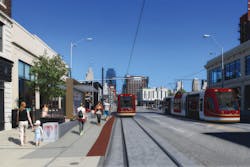Anyone who has tried can tell you that getting a streetcar in the ground isn’t easy.
Cities across the U.S. have grappled with critics who slam streetcars as an out-of-date form of transportation resurrected from a bygone era that lacks the flexibility of bus service. However, when the first left of a streetcar system is built, many critics are silenced and the city can then reap the economic benefits of fixed route transit.
But once the political battles die down, it’s time to move onto the second phase of the new streetcar in order to build a bigger system. While the political challenge may change, it’s still not an easy task.
Getting the first leg up and running
Adam Mohney, marketing specialist for Brookville, which is supplying cars for the new Dallas streetcar system slated to go online later this year, said when delivering units to an operator, the company makes sure to work with them to get the initial units ready to work and to provide any assistance needed for an extension of the system down the line.
When a new line is started, Mohney said Brookville customizes its training and manuals for the operators to make it as relevant to the system and best for its long-term goals. Personnel is also left on site for one year after the initial leg opens, so the operators of the line will have someone to guide them along and make sure they understand how to run and maintain the streetcar before it’s expanded.
“We take a very comprehensive approach to the supplemental material in all the training we provide,” he said.
Ralph Davis, city engineer for Kansas City, which is finishing its final design on the first phase of its streetcar, said there were a number of studies done on extension routes, which have been boiled down to three potential extensions. The city has conducted interviews and is nearly set to select a firm to do the conceptual engineering and design of the extensions with the expectation of picking a finalist in May.
While the initial line will act more in a circulator fashion, Davis said the extensions will have stops spread further apart. While it probably won’t meet a light rail standard, the system will likely take more of a European tram mentality.
“It’s still more of a circulator, but it will kind of have an enhanced role in the extension routes,” he said.
Going into the next phases of development of the system Davis said he doesn’t expect the process to change too much because the extensions will still be going through neighborhoods.
In July, the city of Tucson hopes to begin service on its brand new four-mile streetcar line, which will run in the downtown area of the city. While transit Administrator Shellie Ginn says all efforts now are concentrated on making the initial line a success, once the benefits of the line are seen it would then be time to start looking at extensions.
Ginn said the initial Tucson line wasn’t determined by mileage, but on how to better connected activity centers in the city. A major challenge was getting past barriers like I-10 and Union Pacific Railroad tracks, which provided barriers between redevelopment areas on the western edge of the line.
One of the biggest benefits the city had in planning the route, Ginn said, is the decision to purchase streetcars from Oregon Ironworks because it meant going to Portland, Ore., often and seeing what worked on that city’s line.
“We rode the Portland Streetcar all the time to see what worked and were talking with the drivers, going into the maintenance facilities with staff,” she said. “It really gave us an idea of how something would work for us or judging by our observations if there was something that we didn’t want to go in that direction.”
Deciding what comes next
Building and funding the first leg of a streetcar system in the U.S. has been a major political challenge for most communities given the political fervor the projects bring from opponents and proponents, supporters continue to claim that once the first line opens everyone changes and wants to know when the next line will open. While the conversation may change, that doesn’t mean the political battles disintegrate, they change in nature.
Dave Vozzolo, streetcar program director for HDR, said communities have a clear idea of what they’re trying to accomplish in the first leg of a streetcar system and it then becomes a challenge in deciding what the next steps will tackle. This can create challenges within the community as it determines the priorities of the second leg of the system because different stakeholders will want to prioritize different issues and how the extension will be funded.
“That leads me to another issue, which is the funding issue,” he said. “If the starter line uses some kind of assessment district with a boundary area around just that service area or a sales tax or special property tax assessment, you have to think about how you’re going to fund that next line and if you’re going to extend that special assessment into these new service areas because it can get pretty complicated.”
One issue Kansas City will have to tackle is the addition of more vehicles and how they will be paid for. The city purchased four CAF units as part of a piggyback order with Cincinnati, but Davis said the city will have to determine how to get funding in place to get more vehicles.
Studies have been done on possible extensions of the Tucson streetcar, but Ginn said planners are keeping their options open on possible routes or what the system could look like. Some proposed extensions could potentially look like light rail, but other parts of the system may work better as a true circulator.
“It could be a combination but it needs to be studied more for the direction for the way we want to go and that it makes sense,” she said.
Luke Olson, central region streetcar director for HDR, said when engineering for the first line begins, planners engineers need to be looking into potential expansions and what will make the in terms of extensions and how they’ll connect into the starter line.
“Even when we’re going into the starter line, we’re thinking about what decisions could be made in the future for an extension,” he said. “For example, going down 18th Street may seem a logical corridor to consider in the future, but you need to consider how that would connect into our starter alignment on Main Street and making sure we’re not prohibiting the ability to go in that direction that you may want to consider in the future.”
Old decisions can be positive future steps
Vozzolo said new lines on a streetcar do have a much more expedited process in planning because a lot of the details about the system have already been settled. The first leg entails finding the starting corridor, choosing vehicles, platform designs, how the system will run in the street, how fare collection will happen and how shelters and stations will look. However, these issues are already settled when the second line is planned.
Utility moves can be some of the most contentious parts of streetcar planning and construction, however, with proper planning and working with the utilities, Vozzolo said issues can be mitigated by making sure to work with private utilities in a good manner as soon the initial phase is planned and making sure you minimize the impact on them.
“I remember one case where we worked with them and moved a stop and it saved the utility $5 million in costs,” he said. “It does get easier if you work with them on the first phase because they’re going to remember that and on the extensions they’re going to remember that and it’s going to make the conversation a little easier because they see you’re not just trying to connect the dots, you’re actually trying to work with them to avoid utilities. You try to minimize those impacts. There is no magic bullet; there’s always going to be utilities to deal with one way or another because it’s not like all of a sudden there isn’t going to be utilities.”
Ginn said planners also learned a lot about the issues of streetcar building as the first line runs through the oldest part of Tucson, so there were a lot of utilities to handle in the building process.
Planning and building the Tucson streetcar has been a 10-year process, Ginn said, so in that time the city and planners have learned a lot of valuable practices and insights in how to better plan and communicate with different members of the community.
Ginn said Tucson plans to put together a best practices study on the streetcar process that could be shared with other cities looking to implement streetcars in order to mitigate issues. One issue Tucson learned was the importance of addressing safety and security early in the design phase as opposed to later in order to look at all potential safety issues in a thorough manner. The city also learned the importance in communicating aspects of the project to residents because when they see tracks, overhead wires or a streetcar being tested, they may not understand what to do.
“You may have to just overkill on communications,” she said. “We just really need to educate them on what’s involved when the tracks and overhead wires are installed.”
And in Kansas City, Davis said communication has also proven to be a valuable tool in the building process, so it’s important they beef up their efforts when planning extensions in order to avoid pitfalls when they enter a new neighborhood.
“We’re still in the neighborhoods and still in front of businesses and property owners and they will still have the same concerns about access,” Davis said. “We will still have to go through those same steps and we won’t be able to skip these steps. While it’s somewhat easier, but while at the sometime you still have to go through a lot of the same issues.
“I think what we found is that we do need to make lots of personal contacts within these neighborhoods and residents because they’re going to tell you their specific concerns and we want to hear those concerns and we want to write them down,” Davis said. “A lot of it is you can’t have too much communication and that’s a real lesson.
“We will make sure we have more of these interactions because at a point having a public meeting isn’t ever enough so you need to canvass those directly impacted.”
About the Author
Joe Petrie
Associate Editor
I came to Mass Transit in 2013 after spending seven years on the daily newsbeat in southeastern Wisconsin.
Based in Milwaukee, I worked as a daily newspaper reporter with the Waukesha Freeman from 2006-2011, where I covered education, county and state government. I went on to cover courts for Patch.com, where I was the main courts reporter in the Metro Milwaukee cluster of websites.
I’ve won multiple awards during the course of my career and have covered some of the biggest political events in the past decade and have appeared on national programs.
Having covered local government and social issues, I discovered the importance of transit and the impact it can have on communities when implemented, supported and funded.

